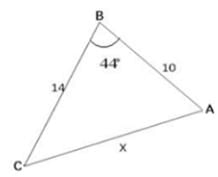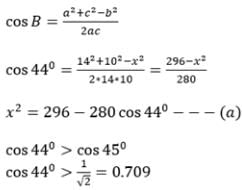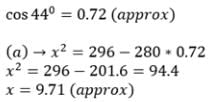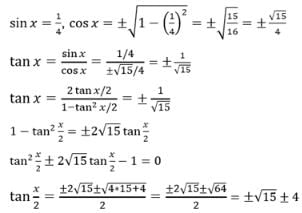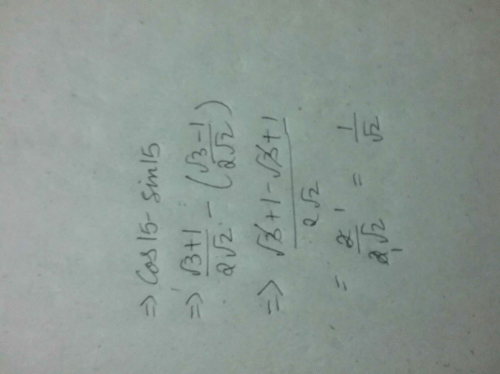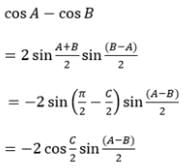All Exams >
Grade 12 >
Mathematics for Grade 12 >
All Questions
All questions of Trigonometric Equations for Grade 12 Exam
In which quadrant are sin, cos and tan positive?a)... moreIInd quadrantb)IVth quadrantc)IIIrd quadrantd)Ist quadrantCorrect answer is 'D'. Can you explain this answer?

|
Anshu Joshi answered |
- All three of them are positive in Quadrant I
- Sine only is positive in Quadrant II
- Tangent only is positive in Quadrant III
- Cosine only is positive in Quadrant IV

Can you explain the answer of this question below:tan x = - 5/12, x lies in the second quadrant. So sinx=?
- A:
5/13
- B:
-5/13
- C:
-12/13
- D:
12/13
The answer is a.
tan x = - 5/12, x lies in the second quadrant. So sinx=?
5/13
-5/13
-12/13
12/13
|
|
Krishna Iyer answered |
tanx = -5/12
Therefore perpendicular = -5, base = 12
Applying pythagoras theorem,
(hyp)2 = (per)2 + (base)2
⇒ (-5)2 + (12)2
hyp = [25+144]1/2
hyp = (169)1/2
hyp = 13
sinx = perpendicular/hypotenous
= -5/13
In second quadrant, only sin x, cosec x are positive
So. sinx = 5/13
Therefore perpendicular = -5, base = 12
Applying pythagoras theorem,
(hyp)2 = (per)2 + (base)2
⇒ (-5)2 + (12)2
hyp = [25+144]1/2
hyp = (169)1/2
hyp = 13
sinx = perpendicular/hypotenous
= -5/13
In second quadrant, only sin x, cosec x are positive
So. sinx = 5/13
What is the value of sin 7π ?
- a)1
- b)-1
- c)-1/2
- d)0
Correct answer is option 'D'. Can you explain this answer?
What is the value of sin 7π ?
a)
1
b)
-1
c)
-1/2
d)
0
|
|
Om Desai answered |
Sin 7π = Sin 7*180 = Sin 2π * 7 = 0
# Remember Sin nπ =0
# Remember Sin nπ =0
In which quadrant are sin, cos and tan positive?- a)IInd quadrant
- b)IVth quadrant
- c)IIIrd quadrant
- d)Ist quadrant
Correct answer is option 'B'. Can you explain this answer?
In which quadrant are sin, cos and tan positive?
a)
IInd quadrant
b)
IVth quadrant
c)
IIIrd quadrant
d)
Ist quadrant
|
|
Nandini Patel answered |
For an angle in the fourth quadrant the point P has positive x coordinate and negative y coordinate. Therefore: In Quadrant IV, cos(θ) > 0, sin(θ) < 0 and tan(θ) < 0 (Cosine positive). The quadrants in which cosine, sine and tangent are positive are often remembered using a favorite mnemonic.
tan 15° =- a)√3 - 1
- b)√3 + 1
- c)

- d)

Correct answer is option 'C'. Can you explain this answer?
tan 15° =
a)
√3 - 1
b)
√3 + 1
c)
d)
|
|
Preeti Iyer answered |
In any traingle The sum of 3 sides of a traingle is equal to 180°
Given
A=72°
B=48°
A+B+C=180°
72°+48°+C=180°
C=180°-120°
C=60°
Can you explain the answer of this question below:What is the value of 
- A:√3/2
- B:1/2
- C:1
- D:1/√2
The answer is d.
What is the value of 
A:
√3/2
B:
1/2
C:
1
D:
1/√2
|
|
Harshitha Mehta answered |
We know ,π = 180deg
So cos 41π/4 = Cos( 41*180/4)
= Cos (1845deg)
= Cos (1800 + 45)
= Cos (10π + π/4)
= Cos (π/4)
= 1/√2
What is the range of cos function?
- a)[-1,0]
- b)[0,1]
- c)[-1,1]
- d)[-2,2]
Correct answer is option 'C'. Can you explain this answer?
What is the range of cos function?
a)
[-1,0]
b)
[0,1]
c)
[-1,1]
d)
[-2,2]
|
|
Om Desai answered |
Just look at the graph of cosine.
We know , Range of a function is the set of all possible outputs for that function. If you look at any 2π interval, the cosine function is periodic after every 2π. as you can see it value range between -1 to 1 along the y-axis . So the range for cos function is [-1,1]
The value of tan 
- a)√2 + 1
- b)√2 – 1
- c)±√2 – 1
- d)-√2 – 1
Correct answer is option 'B'. Can you explain this answer?
The value of tan 
a)
√2 + 1
b)
√2 – 1
c)
±√2 – 1
d)
-√2 – 1
|
|
Krishna Iyer answered |
tan(45°) = tan(45°/2 + 45°/2)
= 2tan(45°/2)/(1 - tan2(45°/2))
(Using expansion for tan(2x))
This implies, 1 = 2tan(45°/2)/(1 - tan2(45°/2))
Rearranging terms, tan2(45°/2) + 2tan(45°/2) - 1 = 0
Solving the quadratic equation x2 + 2x - 1 = 0 gives
x = (√2 - 1) or (-√2 - 1)
But tan(45°/2) lies in the first quadrant, therefore it should be positive.
tan(45°/2) = (√2 - 1)
= 2tan(45°/2)/(1 - tan2(45°/2))
(Using expansion for tan(2x))
This implies, 1 = 2tan(45°/2)/(1 - tan2(45°/2))
Rearranging terms, tan2(45°/2) + 2tan(45°/2) - 1 = 0
Solving the quadratic equation x2 + 2x - 1 = 0 gives
x = (√2 - 1) or (-√2 - 1)
But tan(45°/2) lies in the first quadrant, therefore it should be positive.
tan(45°/2) = (√2 - 1)
Which of the following cannot be the value of cos θ .- a)1
- b)-1
- c)√2
- d)0
Correct answer is option 'C'. Can you explain this answer?
Which of the following cannot be the value of cos θ .
a)
1
b)
-1
c)
√2
d)
0
|
|
Naina Sharma answered |
√2 cannot be the value for Cosθ.
The values of Cos θ at different angles are given below :
Cos0°=1
Cos30°=√3/2
Cos45°=1/√2
Cos60°=1/2
Cos90°=0
sin (n+1)x cos(n+2)x-cos(n+1)x sin(n+2)x=- a)cosx
- b)sinx
- c)-cosx
- d)-sinx
Correct answer is option 'D'. Can you explain this answer?
sin (n+1)x cos(n+2)x-cos(n+1)x sin(n+2)x=
a)
cosx
b)
sinx
c)
-cosx
d)
-sinx
|
|
Neha Joshi answered |
sin(n+1)x cos(n+2)x - cos(n+1)x sin(n+2)x
⇒ sin[(n+1)x - (n+2)x]
As we know that sin(A-B) = sinA cosB - cosA sinB
⇒ sin(n+1-n-2)
sin(-x)
= -sinx
⇒ sin[(n+1)x - (n+2)x]
As we know that sin(A-B) = sinA cosB - cosA sinB
⇒ sin(n+1-n-2)
sin(-x)
= -sinx
What is the sign of the sec θ and cosec θ in second quadrant respectively?- a)positive and negative
- b)positive and positive
- c)negative and negative
- d)negative and positive
Correct answer is option 'D'. Can you explain this answer?
What is the sign of the sec θ and cosec θ in second quadrant respectively?
a)
positive and negative
b)
positive and positive
c)
negative and negative
d)
negative and positive
|
|
Preeti Iyer answered |
In quadrant sin, cos tan, cot, sec, cosec all +ve .In second quadrant sin and cosec are +ve. in 3rd quadrant tan and cot are positive.And in 4th cos and sec are +ve. 

Find the value of sin θ/3- a)

- b)

- c)

- d)

Correct answer is option 'B'. Can you explain this answer?
Find the value of sin θ/3
a)
b)
c)
d)

|
Top Rankers answered |
sin θ/3
Multiply and divide it by '2'
sin2(θ/3*2) = sin2(θ/6)
As we know that sin2θ = 2sinθcosθ
=> 2 sin(θ/6) cos(θ/6)
Multiply and divide it by '2'
sin2(θ/3*2) = sin2(θ/6)
As we know that sin2θ = 2sinθcosθ
=> 2 sin(θ/6) cos(θ/6)
cosA + cos (120° + A) + cos(120° – A) =- a)-1/2
- b)1/2
- c)1
- d)0
Correct answer is option 'D'. Can you explain this answer?
cosA + cos (120° + A) + cos(120° – A) =
a)
-1/2
b)
1/2
c)
1
d)
0
|
|
Raghav Bansal answered |
CosA + Cos(120o-A) + Cos(120°+A)
cosA + 2cos(120° - a + 120° + a)/(2cos(120° - a - 120° - a)
we know that formula
(cos C+ cosD = 2cos (C+D)/2.cos (C-D) /2)
⇒ cosA + 2cos120° cos(-A)
⇒ cosA+ 2cos (180° - 60°) cos(-A)
⇒ cosA + 2(-cos60°) cosA
⇒ cos A - 2 * 1/2cos A
⇒ cosA-cosA
⇒ 0
cosA + 2cos(120° - a + 120° + a)/(2cos(120° - a - 120° - a)
we know that formula
(cos C+ cosD = 2cos (C+D)/2.cos (C-D) /2)
⇒ cosA + 2cos120° cos(-A)
⇒ cosA+ 2cos (180° - 60°) cos(-A)
⇒ cosA + 2(-cos60°) cosA
⇒ cos A - 2 * 1/2cos A
⇒ cosA-cosA
⇒ 0
If cos A + cos B =  , then the sides of the triangle ABC are in
, then the sides of the triangle ABC are in- a)H. P.
- b)A. P.
- c)G. P.
- d)none of these
Correct answer is option 'B'. Can you explain this answer?
If cos A + cos B =  , then the sides of the triangle ABC are in
, then the sides of the triangle ABC are in
a)
H. P.
b)
A. P.
c)
G. P.
d)
none of these
|
|
Aryan Khanna answered |
cos A + cos B = 4 sin2(C/2)
⇒ 2 cos (A+B)/2 cos (A−B)/2 = 4 sin2(C/2)
⇒ 2 cos (A+B)/2 cos (A−B)/2 = 4 sin2(C/2)
∵ A + B + C = π ⇒ A + B = π − C
⇒ cos (π−C)/2 cos (A−B)/2 = 2 sin2(C/2)
⇒ sin C/2 cos (A−B)/2 = 2 sin2(C/2)
⇒ cos (A−B)/2 = 2 sin (C/2)
⇒ cos C/2 cos (A−B)/2 = 2 sin (C/2) cos (C/2)
⇒ cos (π−(A+B))/2 cos (A−B)/2 = sin C
⇒ 2 sin (A+B)/2 cos (A−B)/2 = sin C
⇒ sin A + sin B = 2 sin C
⇒ sin C/2 cos (A−B)/2 = 2 sin2(C/2)
⇒ cos (A−B)/2 = 2 sin (C/2)
⇒ cos C/2 cos (A−B)/2 = 2 sin (C/2) cos (C/2)
⇒ cos (π−(A+B))/2 cos (A−B)/2 = sin C
⇒ 2 sin (A+B)/2 cos (A−B)/2 = sin C
⇒ sin A + sin B = 2 sin C
∵ a/sinA = b/sinB = c/sinC = k
⇒sinA = ak, sin B = bk , sin C = ck
⇒sinA = ak, sin B = bk , sin C = ck
⇒ ak + bk = 2(ck)
⇒ a+b=2c
⇒ a+b=2c
Therefore the sides of triangle a,b,c are in A.P.
Two ships A and B, lies 33 m apart on the sea surface. There is submarine ‘C’ on the sea bed. The angle of depression of C from A is 600 and the distance AC is 40 m. Calculate the distance BC.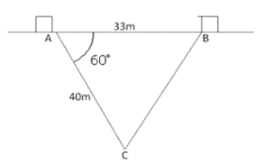
- a)51.9m
- b)37.0m
- c)20.1m
- d)63.3m
Correct answer is option 'B'. Can you explain this answer?
Two ships A and B, lies 33 m apart on the sea surface. There is submarine ‘C’ on the sea bed. The angle of depression of C from A is 600 and the distance AC is 40 m. Calculate the distance BC.
a)
51.9m
b)
37.0m
c)
20.1m
d)
63.3m
|
|
Poonam Reddy answered |
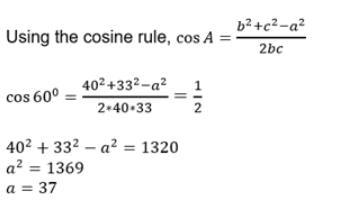
What is the length of side c 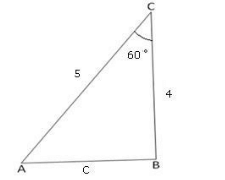
- a)3.58
- b)4.58
- c)4.89
- d)4.56
Correct answer is option 'B'. Can you explain this answer?
What is the length of side c
a)
3.58
b)
4.58
c)
4.89
d)
4.56
|
|
Neha Joshi answered |
a = 4, b = 5
angle c = 60o
cos c = (a2 + b2 - c2)/2ab
= 1/2 = (16 + 25 - c2)/40
⇒ 20 = 41 - c2
c2 = 21
⇒ c = (21)1/2
⇒ c = 4.58
angle c = 60o
cos c = (a2 + b2 - c2)/2ab
= 1/2 = (16 + 25 - c2)/40
⇒ 20 = 41 - c2
c2 = 21
⇒ c = (21)1/2
⇒ c = 4.58
What is the value of sin 35θ – sin55θ?- a)– √2 sin 10°
- b)2sin5θ
- c)1
- d)√2
Correct answer is option 'A'. Can you explain this answer?
What is the value of sin 35θ – sin55θ?
a)
– √2 sin 10°
b)
2sin5θ
c)
1
d)
√2
|
|
Gaurav Kumar answered |
sinA - sinB = 2cos(A+B)/2 sin(A-B)/2
sin 35 – sin55 = 2cos(35+55)/2 sin(35-55)/2
= 2cos45 (-sin10)
= 2(√2/2) (-sin10)
= -√2 sin10
sin 35 – sin55 = 2cos(35+55)/2 sin(35-55)/2
= 2cos45 (-sin10)
= 2(√2/2) (-sin10)
= -√2 sin10
Period of 15csc(x/3) is
- a)15π
- b)5π
- c)2π
- d)6π
Correct answer is option 'D'. Can you explain this answer?
Period of 15csc(x/3) is
a)
15π
b)
5π
c)
2π
d)
6π
|
|
Tejas Verma answered |
15cosec(x/3)= 2π/1/3=6 π
What is the value of cos 1050 + cos750 ?- a)-1/2
- b)1
- c)0
- d)-1
Correct answer is option 'C'. Can you explain this answer?
What is the value of cos 1050 + cos750 ?
a)
-1/2
b)
1
c)
0
d)
-1

|
Lohit Matani answered |
cos105° + cos75°
= cos(90º + 15) + cos(90° - 15)
= - sin15 + sin15 = 0
= cos(90º + 15) + cos(90° - 15)
= - sin15 + sin15 = 0
What is the sign of the sinA and tanA in third quadrant respectively- a)negative and positive
- b)positive and positive
- c)negative and negative.
- d)positive and negative
Correct answer is option 'A'. Can you explain this answer?
What is the sign of the sinA and tanA in third quadrant respectively
a)
negative and positive
b)
positive and positive
c)
negative and negative.
d)
positive and negative
|
|
Suresh Iyer answered |
The sign of the sinA and tanA in third quadrant is negative and positive.
3 Sin 10° – 4 Sin3 10° = ?- a)1
- b)2
- c)-1
- d)1/2
Correct answer is option 'D'. Can you explain this answer?
3 Sin 10° – 4 Sin3 10° = ?
a)
1
b)
2
c)
-1
d)
1/2
|
|
Vikas Kapoor answered |
3sinA-4sin3A=sin3A
Given, 3 sin 10° - 4 sin 3 10°
So, sin3A i.e sin 30
= ½
Given, 3 sin 10° - 4 sin 3 10°
So, sin3A i.e sin 30
= ½
In any ΔABC, the expression (a + b + c) (a + b – c) (b + c – a) (c + a – b) is equal to- a)16Δ
- b)4Δ
- c)4Δ2
- d)none of these
Correct answer is option 'D'. Can you explain this answer?
In any ΔABC, the expression (a + b + c) (a + b – c) (b + c – a) (c + a – b) is equal to
a)
16Δ
b)
4Δ
c)
4Δ2
d)
none of these
|
|
Geetika Shah answered |
Relationship, communication is key. It is important to be honest, open, and clear with your partner about your thoughts, feelings, and needs. When conflicts arise, it is important to approach them with a willingness to listen and understand the other person's perspective. It is also important to establish boundaries and respect each other's individuality. Building trust, showing appreciation and affection, and spending quality time together can also strengthen a relationship.
The range of the function y= cotx is- a)[-1,-1]
- b)R+
- c)π
- d)(-1,1)
Correct answer is option 'C'. Can you explain this answer?
The range of the function y= cotx is
a)
[-1,-1]
b)
R+
c)
π
d)
(-1,1)
|
|
Neha Joshi answered |
Range of cotx is (−∞,+∞)
Explanation:
The cotangent function can take up any values depending on the value of x , the independent variable.
And thus, the range (−∞,+∞) is justified.
And thus, the range (−∞,+∞) is justified.
The domain is all real numbers other than integral multiples of π where, the function is not defined.
sin 51° + cos 81° =?- a)-sin132°
- b)sin132°
- c)-cos21°
- d)cos21°
Correct answer is option 'D'. Can you explain this answer?
sin 51° + cos 81° =?
a)
-sin132°
b)
sin132°
c)
-cos21°
d)
cos21°
|
|
Anjana Sharma answered |
Two angles are said to be complementaryif their su... morem is equals 90 degrees.a ) sin ( 90 - A ) = cos Ab ) cos ( 90 - A ) = sin AAc
The graph of y= cos x meets the x axis at- a)(2n + 1)π/2
- b)nπ/2
- c)(2n + 1)π
- d)nπ
Correct answer is option 'A'. Can you explain this answer?
The graph of y= cos x meets the x axis at
a)
(2n + 1)π/2
b)
nπ/2
c)
(2n + 1)π
d)
nπ

|
Defence Exams answered |
(i) The graph of the function y = cos x is continuous and extends on either side in symmetrical wave form.
(ii) Since the graph of y = cos x intersects the x-axis at the origin and at points where x is an odd multiple of 90°, hence cos x is zero at x = (2n + 1)/π2 where n = 0, ±1, ±2, ±3, ±4, ……………... .
(ii) Since the graph of y = cos x intersects the x-axis at the origin and at points where x is an odd multiple of 90°, hence cos x is zero at x = (2n + 1)/π2 where n = 0, ±1, ±2, ±3, ±4, ……………... .
What is the length of side b.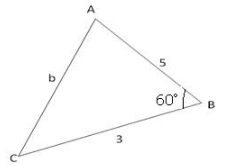
- a)7.16
- b)7.74
- c)2.83
- d)4.35
Correct answer is option 'D'. Can you explain this answer?
What is the length of side b.
a)
7.16
b)
7.74
c)
2.83
d)
4.35

|
Sumair Sadiq answered |
We all know that it is a right angle triangle because it probe the Pythagoras therom
h2 =p2 +b2
25=9+16
25=25
so length of b is 4 unit
no other you can get by also traigle formula
h2 =p2 +b2
25=9+16
25=25
so length of b is 4 unit
no other you can get by also traigle formula
Find angle A in the following figure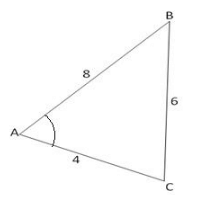
- a)43°30′
- b)40°30’4″
- c)45′
- d)46°36’2″
Correct answer is option 'D'. Can you explain this answer?
Find angle A in the following figure
a)
43°30′
b)
40°30’4″
c)
45′
d)
46°36’2″
|
|
Pooja Shah answered |
As we know that, cosA = (b2 + c2 - a2)/2bc
a = 6, b=4, c=8
cosA = (16+64-36)/2(4)(8)
44/64
= 0.687
A = cos-1(0.687)
which is approx equals to 46°36’2″
a = 6, b=4, c=8
cosA = (16+64-36)/2(4)(8)
44/64
= 0.687
A = cos-1(0.687)
which is approx equals to 46°36’2″
When sinθ + cosθ = 1, then the value of sin2θ is- a)0
- b)2
- c)1
- d)-1
Correct answer is option 'A'. Can you explain this answer?
When sinθ + cosθ = 1, then the value of sin2θ is
a)
0
b)
2
c)
1
d)
-1
|
|
Krishna Iyer answered |
Squaring on both sides,you get sin2x + 2sinxcosx + cos2x = 1
which gives 1 + 2sinxcosx = 1 {since sin2x +cos2x = 1 for all x}
which means,2sinxcosx =0
which means either sinx =0 or cosx=0
so,the general solution is that for sinx=0 union cosx=0
cos9y - cos5y=- a)2sin7y sin 2y
- b)-2cos7y cos 2y
- c)2 cos7ycos2y
- d)-2 sin7y sin2y
Correct answer is option 'D'. Can you explain this answer?
cos9y - cos5y=
a)
2sin7y sin 2y
b)
-2cos7y cos 2y
c)
2 cos7ycos2y
d)
-2 sin7y sin2y
|
|
Jyoti Chopra answered |
Given Expression:
cos9y - cos5y = 2sin7y sin2y
Explanation:
- To simplify the given expression, we can use the trigonometric identity: cos(A) - cos(B) = -2sin[(A + B)/2]sin[(A - B)/2].
Applying the Identity:
cos9y - cos5y = -2sin[(9y + 5y)/2]sin[(9y - 5y)/2]
cos9y - cos5y = -2sin(7y)sin(2y)
Comparing with the Given Expression:
We can see that the given expression matches the simplified form after applying the trigonometric identity.
Answer:
Therefore, the correct answer is option 'D': -2sin7y sin2y.
cos9y - cos5y = 2sin7y sin2y
Explanation:
- To simplify the given expression, we can use the trigonometric identity: cos(A) - cos(B) = -2sin[(A + B)/2]sin[(A - B)/2].
Applying the Identity:
cos9y - cos5y = -2sin[(9y + 5y)/2]sin[(9y - 5y)/2]
cos9y - cos5y = -2sin(7y)sin(2y)
Comparing with the Given Expression:
We can see that the given expression matches the simplified form after applying the trigonometric identity.
Answer:
Therefore, the correct answer is option 'D': -2sin7y sin2y.
Sin250 sin550 = ?
- a)

- b)

- c)

- d)

Correct answer is option 'B'. Can you explain this answer?
Sin250 sin550 = ?
a)

b)

c)

d)


|
Infinity Academy answered |
sin25° sin55°
Multiply and divide by '2'
1/2(2 sin25° sin55°)
cos(a-b) + cos(a+b) = 2sina sinb
1/2[cos(a-b) - cos(a+b)] = sina sinb
1/2[cos(25° - 55°) - cos(25° + 55°)] = sin25° sin55°
1/2[cos(-30°) - cos(80°)] = sin25° sin55°
1/2[cos(30°) - cos(80°)] = sin25° sin55°
Multiply and divide by '2'
1/2(2 sin25° sin55°)
cos(a-b) + cos(a+b) = 2sina sinb
1/2[cos(a-b) - cos(a+b)] = sina sinb
1/2[cos(25° - 55°) - cos(25° + 55°)] = sin25° sin55°
1/2[cos(-30°) - cos(80°)] = sin25° sin55°
1/2[cos(30°) - cos(80°)] = sin25° sin55°
Which of the following is positive?- a)sec 120°
- b)sin 240°
- c)tan 315°
- d)cos 330°
Correct answer is option 'D'. Can you explain this answer?
Which of the following is positive?
a)
sec 120°
b)
sin 240°
c)
tan 315°
d)
cos 330°

|
Anonymous answered |
Sec is always positive if the angle belongs to first or fourth quadrant
120 belongs to second quadrant. Therefore sec120 is negative
sin is positive if angle is in first or second quadrant
240 belongs to third. Sin240 is negative
Tan is positive if angle is in first and third quadrant
315 belongs to fourth. Tan315 is negative
Cos is similar to sec. 330 belongs to fourth quadrant
Cos330 is positive
120 belongs to second quadrant. Therefore sec120 is negative
sin is positive if angle is in first or second quadrant
240 belongs to third. Sin240 is negative
Tan is positive if angle is in first and third quadrant
315 belongs to fourth. Tan315 is negative
Cos is similar to sec. 330 belongs to fourth quadrant
Cos330 is positive
If cos θ = 1/√5 what is the value of cos 2θ?- a)-3/5
- b)√2/5
- c)3/5
- d)-2/√5
Correct answer is option 'A'. Can you explain this answer?
If cos θ = 1/√5 what is the value of cos 2θ?
a)
-3/5
b)
√2/5
c)
3/5
d)
-2/√5
|
|
Krishna Iyer answered |
cos 2θ = 2cos2θ - 1
= 2(1/√5)2 - 1
= 2/5 - 1
= -3/5
= 2(1/√5)2 - 1
= 2/5 - 1
= -3/5
In a triangle ABC, is equal to
is equal to- a)

- b)

- c)

- d)none of these
Correct answer is option 'C'. Can you explain this answer?
In a triangle ABC, is equal to
is equal to
a)
b)
c)
d)
none of these
|
|
Kinni answered |
Correct answer is option'C:
The Magnitude of the function 3sin x
- a)3
- b)-3
- c)0
- d)1
Correct answer is option 'A'. Can you explain this answer?
The Magnitude of the function 3sin x
a)
3
b)
-3
c)
0
d)
1
|
|
Krishna Iyer answered |
The Magnitude of y = 3sinx is 3.
graph{y=-3*sinx [-10, 10, -5, 5]}
Amplitude is the height of a periodic function, aka the distance from the center of the wave to it's highest point (or lowest point). You can also take the distance from the highest point to the lowest point of the graph and divide it by two.
graph{y=-3*sinx [-10, 10, -5, 5]}
Amplitude is the height of a periodic function, aka the distance from the center of the wave to it's highest point (or lowest point). You can also take the distance from the highest point to the lowest point of the graph and divide it by two.
The period of y = sin 5x is- a)2π/5
- b)π/5
- c)2π/a
- d)2π
Correct answer is option 'A'. Can you explain this answer?
The period of y = sin 5x is
a)
2π/5
b)
π/5
c)
2π/a
d)
2π
|
|
Lavanya Menon answered |
Period of sin x is 2π.
Period of sin 5x is 2π/5
Period of sin 5x is 2π/5
The area of a triangle is 80cm2 and its perimeter is 8 cm. The radius of its inscribed circle is
- a)20 cm
- b)10 cm
- c)5 cm
- d)none of these
Correct answer is option 'A'. Can you explain this answer?
The area of a triangle is 80cm2 and its perimeter is 8 cm. The radius of its inscribed circle is
a)
20 cm
b)
10 cm
c)
5 cm
d)
none of these
|
|
Naina Sharma answered |
Area of a triangle = 80 cm2, a + b + c = 8 cm
s = perimeter/2=(a + b + c)/2 = 8/2 = 4 cm
s = perimeter/2=(a + b + c)/2 = 8/2 = 4 cm
Radius of inscribed circle (r) = (area of the triange)/s = 80/4 = 20 cm
cosA - cos3A =- a)-2 sin2AsinA
- b)2 sin2A sinA
- c)-2sinAsin2A
- d)2sin Asin2A
Correct answer is option 'B'. Can you explain this answer?
cosA - cos3A =
a)
-2 sin2AsinA
b)
2 sin2A sinA
c)
-2sinAsin2A
d)
2sin Asin2A
|
|
Sankar Choudhury answered |
Solution:
We know that,
cos(3A) = 4cos^3(A) - 3cos(A)
Therefore,
cos(A) - cos(3A) = cos(A) - [4cos^3(A) - 3cos(A)]
= 4cos^3(A) - 2cos(A)
= 2cos(A)(2cos^2(A) - 1)
= 2cos(A)(cos(2A))
= 2cos(A)(2cos^2(A) - 1)
= 4cos^3(A) - 2cos(A)
= 2cos(A)(2cos^2(A) - 1)
= 2cos(A)(cos(2A))
= 2sin(A)sin(2A)
= 2sin^2(A)cos(A)
= 2sin(A)sin(2A)
Hence, the correct option is (B).
We know that,
cos(3A) = 4cos^3(A) - 3cos(A)
Therefore,
cos(A) - cos(3A) = cos(A) - [4cos^3(A) - 3cos(A)]
= 4cos^3(A) - 2cos(A)
= 2cos(A)(2cos^2(A) - 1)
= 2cos(A)(cos(2A))
= 2cos(A)(2cos^2(A) - 1)
= 4cos^3(A) - 2cos(A)
= 2cos(A)(2cos^2(A) - 1)
= 2cos(A)(cos(2A))
= 2sin(A)sin(2A)
= 2sin^2(A)cos(A)
= 2sin(A)sin(2A)
Hence, the correct option is (B).
The period of the function y = 5 sin x/2 is- a)2π
- b)3π
- c)4π
- d)π
Correct answer is option 'C'. Can you explain this answer?
The period of the function y = 5 sin x/2 is
a)
2π
b)
3π
c)
4π
d)
π
|
|
Lavanya Menon answered |
Period = 2π/|b|
As it is given a =5, b = 1/2
period = 2π/|1/2|
⇒ 4π
As it is given a =5, b = 1/2
period = 2π/|1/2|
⇒ 4π
The period of the function y = tan x is- a)2π
- b)π
- c)not defined
- d)zero
Correct answer is option 'B'. Can you explain this answer?
The period of the function y = tan x is
a)
2π
b)
π
c)
not defined
d)
zero
|
|
Lavanya Menon answered |
The period of y=tanx is π.
Since the function y = tan x is periodic of period π hence each branch is simply a repetition of the branch from -
(-π/2 , π/2).
Since the function y = tan x is periodic of period π hence each branch is simply a repetition of the branch from -
(-π/2 , π/2).
In a ΔABC, (b +c) cos A + (c + a) cos B + (a + b) cos C is equal to- a)R r
- b)a + b + c
- c)0
- d)none of these
Correct answer is option 'B'. Can you explain this answer?
In a ΔABC, (b +c) cos A + (c + a) cos B + (a + b) cos C is equal to
a)
R r
b)
a + b + c
c)
0
d)
none of these
|
|
Om Desai answered |
(b+c) cos A + (c + a) cos B + (a + b) cos C
⇒ b cos A + c cos A + c cos B + a cos B + a cos C + b cos C
⇒ (b cos C + c cos B) + (c cos A + a cos C) + (a cos B + b cos A) ...(1)
Using projection formula,
a = (b cos C + c cos B) ...(2)
b = (c cos A + a cos C) ...(3)
c = (a cos B + b cos A) ...(4)
⇒ b cos A + c cos A + c cos B + a cos B + a cos C + b cos C
⇒ (b cos C + c cos B) + (c cos A + a cos C) + (a cos B + b cos A) ...(1)
Using projection formula,
a = (b cos C + c cos B) ...(2)
b = (c cos A + a cos C) ...(3)
c = (a cos B + b cos A) ...(4)
On adding the projection formula, we get the initial expression
i.e. (2) + (3) + (4) = (1)
∴ (b + c) cos A + (c + a) cos B + (a + b) cos C = a + b + c
i.e. (2) + (3) + (4) = (1)
∴ (b + c) cos A + (c + a) cos B + (a + b) cos C = a + b + c
If the sides of a triangle are 13, 7, 8 the greatest angle of the triangle is- a)p/2
- b)p/3
- c)2p/3
- d)3p/2
Correct answer is option 'C'. Can you explain this answer?
If the sides of a triangle are 13, 7, 8 the greatest angle of the triangle is
a)
p/2
b)
p/3
c)
2p/3
d)
3p/2
|
|
Nandini Iyer answered |
a = 13, b = 7, c = 8
By cosine formula,
⇒ A = 120º = 2π/3
By cosine formula,

⇒ A = 120º = 2π/3
The angles of a triangle are as 1 : 2 : 7, then ratio of greatest side to least side is- a)

- b)

- c)

- d)(√5–+1):(√5−1)
Correct answer is option 'D'. Can you explain this answer?
The angles of a triangle are as 1 : 2 : 7, then ratio of greatest side to least side is
a)
b)
c)
d)
(√5–+1):(√5−1)
|
|
Gaurav Kumar answered |
Let the angles be x, 2x, and 7x respectively.
⇒ x + 2x + 7x = 180° [angle sum property of triangle]
⇒ 10x = 180°
⇒ x = 18°
Hence, the angles are: 18°,36°,126°
⇒ x + 2x + 7x = 180° [angle sum property of triangle]
⇒ 10x = 180°
⇒ x = 18°
Hence, the angles are: 18°,36°,126°

⇒ Greatest Side = K sin 126°
⇒ Smallest side = K sin 18°
So, required ratio =K sin 126°/ K sin 18°
= sin(90°+36°)/sin18°= cos36°/sin18° [sin(90°+x)=cosx]
= (√5+1)/(√5−1)
Chapter doubts & questions for Trigonometric Equations - Mathematics for Grade 12 2025 is part of Grade 12 exam preparation. The chapters have been prepared according to the Grade 12 exam syllabus. The Chapter doubts & questions, notes, tests & MCQs are made for Grade 12 2025 Exam. Find important definitions, questions, notes, meanings, examples, exercises, MCQs and online tests here.
Chapter doubts & questions of Trigonometric Equations - Mathematics for Grade 12 in English & Hindi are available as part of Grade 12 exam.
Download more important topics, notes, lectures and mock test series for Grade 12 Exam by signing up for free.
Mathematics for Grade 12
270 videos|267 docs|155 tests
|

Contact Support
Our team is online on weekdays between 10 AM - 7 PM
Typical reply within 3 hours
|
Free Exam Preparation
at your Fingertips!
Access Free Study Material - Test Series, Structured Courses, Free Videos & Study Notes and Prepare for Your Exam With Ease

 Join the 10M+ students on EduRev
Join the 10M+ students on EduRev
|

|
Create your account for free
OR
Forgot Password
OR
Signup on EduRev and stay on top of your study goals
10M+ students crushing their study goals daily



